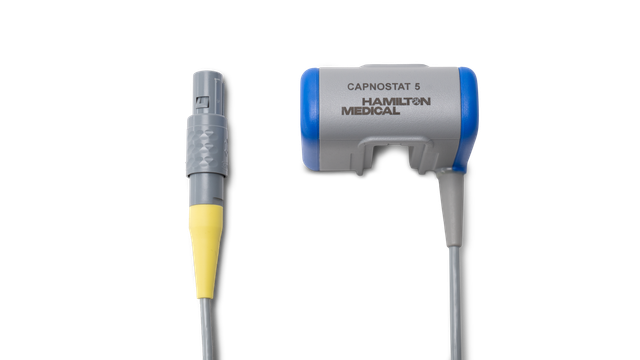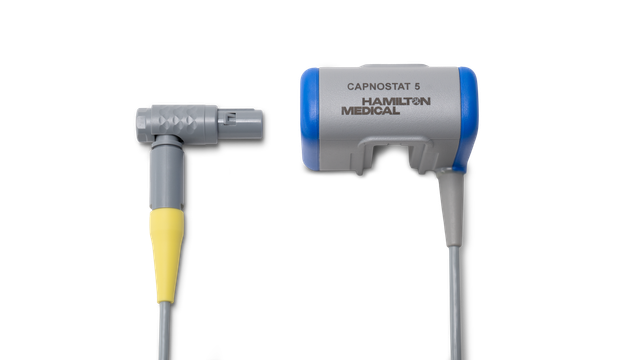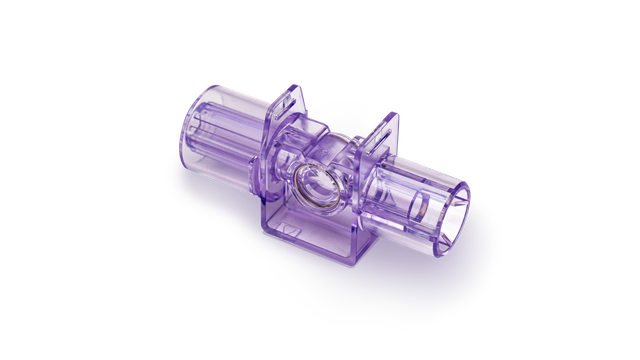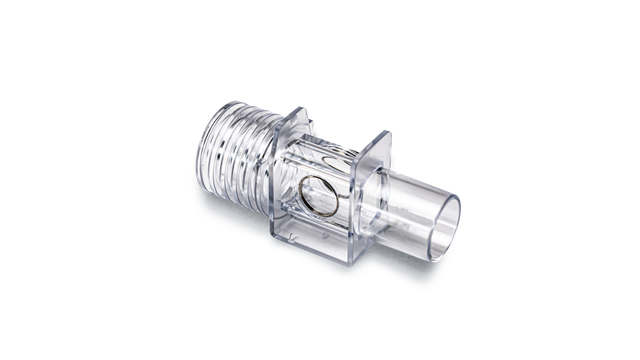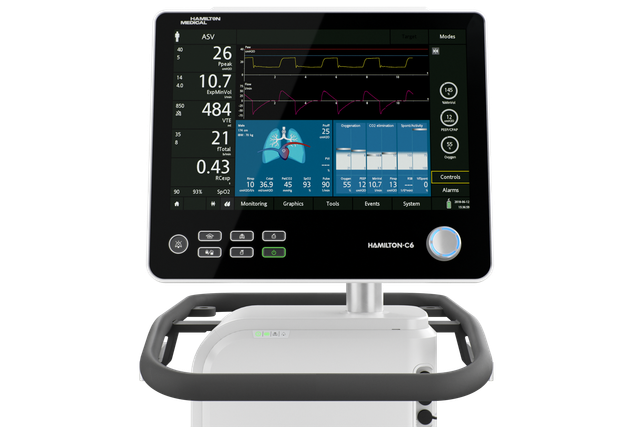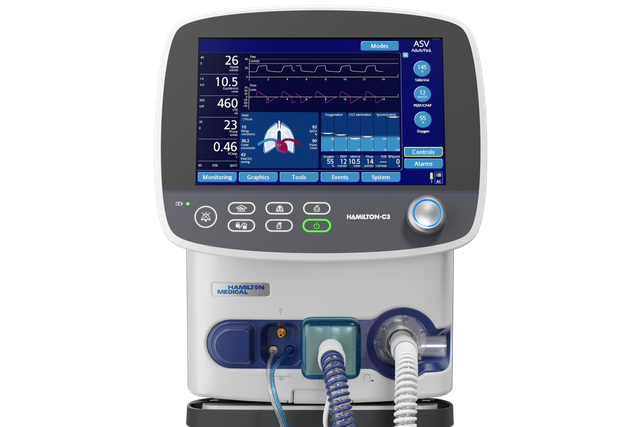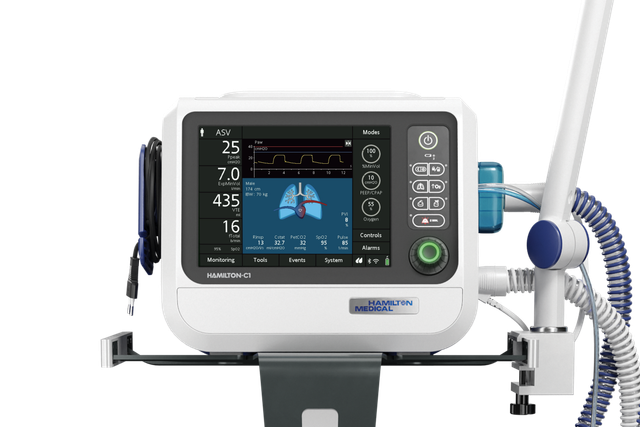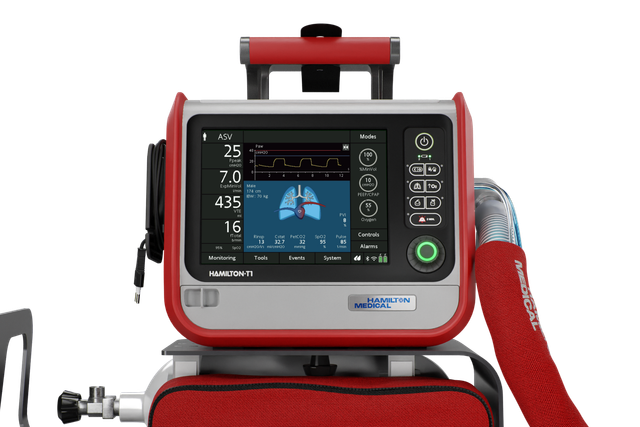
Dati più completi: monitoraggio volumetrico della CO2
Le fasi, la forma e la morfologia della curva di un capnogramma volumetrico, insieme ai valori calcolati a partire dalle misure, possono dire molto su:
- Efficienza di ventilazione/perfusione
- Frazione di spazio morto fisiologica
- Tasso metabolico del paziente (
Jaffe MB. Using the features of the time and volumetric capnogram for classification and prediction. J Clin Monit Comput. 2017;31(1):19‑41. doi:10.1007/s10877‑016‑9830‑z1 )
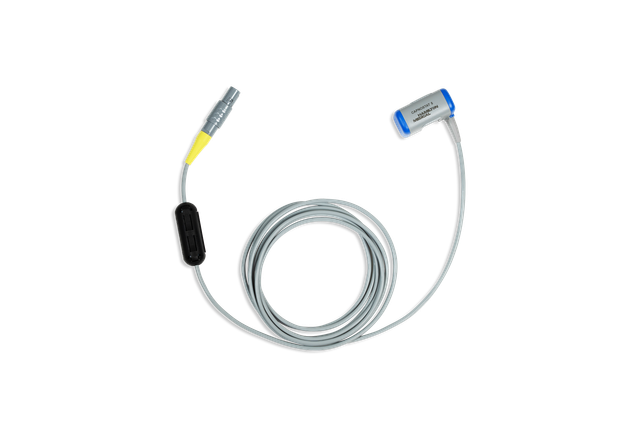
Uno strumento potente: il sensore di CO2
Sui nostri ventilatori, la CO2 viene misurata con un sensore mainstream di CO2 CAPNOSTAT‑5 in posizione prossimale alle vie aeree del paziente.
Il sensore CAPNOSTAT‑5 fornisce misure precise dell'end‑tidal CO2 (PetCO2) e un capnogramma chiaro e accurato a tutte le frequenze respiratorie fino a 150 respiri al minuto.
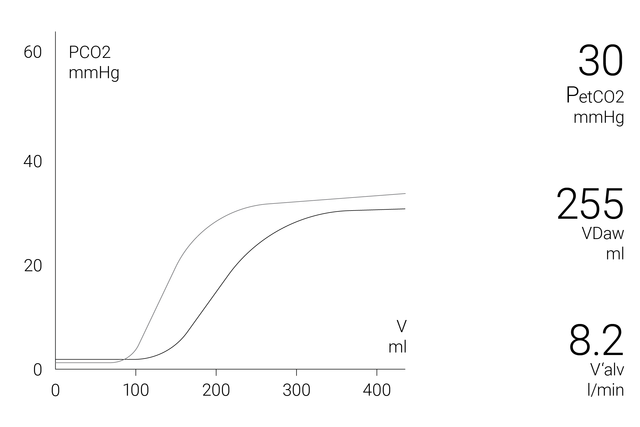
Un sensore piccolo che raccoglie grandi quantità di dati: eccoli tutti
La finestra del capnogramma volumetrico sullo schermo mostra dati quantitativi esatti combinando i dati sul flusso prossimale e i dati sulla CO2, per esempio:
- Curva del capnogramma volumetrico attuale
- Curva di riferimento del capnogramma volumetrico
- Pulsante della curva di riferimento con ora e data del loop di riferimento
- Valori di CO2 più rilevanti, respiro per respiro
Per consentire un'analisi più completa delle condizioni del paziente, sono disponibili i trend su 72 ore (o su 96 ore con ventilatori HAMILTON‑G5/S1) di:
- PetCO2
- V'CO2
- FetCO2
- VeCO2
- ViCO2
- Vtalv
- Valv
- Vds
- VD/Vt
- VDaw/VTE
- slopeCO2
Per semplificare le cose, i ventilatori Hamilton Medical offrono una panoramica di tutti i valori rilevanti legati alla CO2 nella finestra Monitoraggio CO2.
- Concentrazione CO2 frazionale di fine espirazione: FetCO2 (%)
- Pressione CO2 di fine espirazione: PetCO2 (mmHg)
- Pendenza del plateau alveolare nella curva PetCO2, che indica lo stato di volume/flusso dei polmoni: slopeCO2 (%CO2/l)
- Ventilazione corrente alveolare: Vtalv (ml)
- Ventilazione minuto alveolare: Valv (l/min)
- Eliminazione della CO2: V’CO2 (ml/min)
- Spazio morto delle vie aeree: Vds (ml)
- Frazione di spazio morto delle vie aeree all'apertura delle vie aeree: VDaw/VTE (%)
- Volume di CO2 espirato: VeCO2 (ml)
- Volume di CO2 inspirato: ViCO2 (ml)
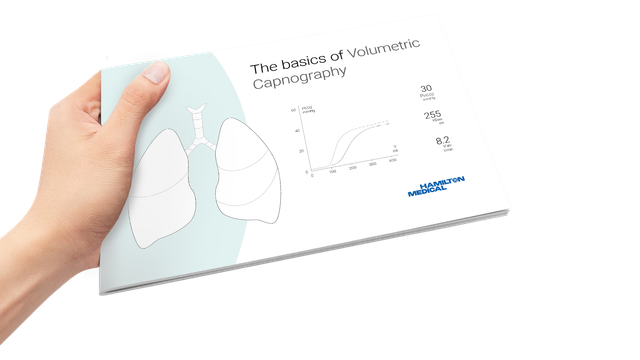
E‑book gratuito
Buono a sapersi! Tutto sulla capnografia volumetrica
Tutto quel che serve per interpretare un capnogramma volumetrico e avere una panoramica dei vantaggi e delle applicazioni cliniche della capnografia volumetrica. Comprende un test da eseguire in autonomia!
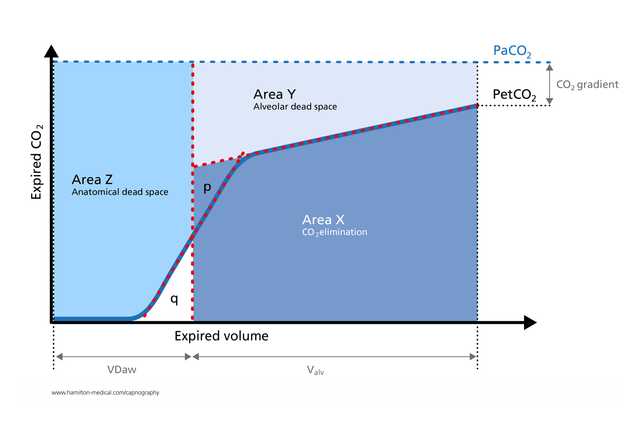
Quali sono i vantaggi? Uno sguardo alle prove
Il capnogramma volumetrico è stato utilizzato con risultati positivi per misurare lo spazio morto anatomico, la perfusione capillare polmonare e l'efficienza della ventilazione (
Romero PV, Lucangelo U, Lopez Aguilar J, Fernandez R, Blanch L. Physiologically based indices of volumetric capnography in patients receiving mechanical ventilation. Eur Respir J. 1997;10(6):1309‑1315. doi:10.1183/09031936.97.100613092 )I valori calcolati sulla base della capnografia volumetrica sono utili per identificare un'eventuale embolia polmonare al posto letto (
Blanch L, Romero PV, Lucangelo U. Volumetric capnography in the mechanically ventilated patient. Minerva Anestesiol. 2006;72(6):577‑585. 3 )In uno studio condotto su pazienti con ARDS sottoposti a ventilazione meccanica, le misure di capnografia volumetrica relative al rapporto tra spazio morto e volume corrente sono risultate accurate quanto i valori ottenuti con la tecnica del monitoraggio metabolico (
Kallet RH, Daniel BM, Garcia O, Matthay MA. Accuracy of physiologic dead space measurements in patients with acute respiratory distress syndrome using volumetric capnography: comparison with the metabolic monitor method. Respir Care. 2005;50(4):462‑467. 4 )Il capnogramma espiratorio è un metodo di misurazione rapido, non invasivo e indipendente dallo sforzo respiratorio che agevola la rilevazione dei casi di broncospasmo significativo nei pazienti adulti con asma (
Yaron M, Padyk P, Hutsinpiller M, Cairns CB. Utility of the expiratory capnogram in the assessment of bronchospasm. Ann Emerg Med. 1996;28(4):403‑407. doi:10.1016/s0196‑0644(96)70005‑75 )Poiché fornisce informazioni preziose e in tempo reale sulla fisiologia del collasso e del reclutamento polmonare in modo non invasivo, la capnografia volumetrica consente di monitorare le manovre di reclutamento cicliche al posto letto (
Tusman G, Suarez‑Sipmann F, Böhm SH, et al. Monitoring dead space during recruitment and PEEP titration in an experimental model. Intensive Care Med. 2006;32(11):1863‑1871. doi:10.1007/s00134‑006‑0371‑76 )

Buono a sapersi! Risorse per la formazione sulla capnografia volumetrica
Accessori e prodotti di consumo
Mettiamo a disposizione prodotti di consumo originali per pazienti adulti, pediatrici e neonatali. È possibile scegliere tra prodotti riutilizzabili e monouso secondo le procedure stabilite dalla struttura sanitaria.
Disponibilità
La capnografia volumetrica è disponibile come opzione sui ventilatori HAMILTON‑C6, HAMILTON‑G5, HAMILTON‑C3 e HAMILTON‑C1/T1; è invece una funzione standard sull'HAMILTON‑S1.
Bibliografia
- 1. Jaffe MB. Using the features of the time and volumetric capnogram for classification and prediction. J Clin Monit Comput. 2017;31(1):19‑41. doi:10.1007/s10877‑016‑9830‑z
- 2. Romero PV, Lucangelo U, Lopez Aguilar J, Fernandez R, Blanch L. Physiologically based indices of volumetric capnography in patients receiving mechanical ventilation. Eur Respir J. 1997;10(6):1309‑1315. doi:10.1183/09031936.97.10061309
- 3. Blanch L, Romero PV, Lucangelo U. Volumetric capnography in the mechanically ventilated patient. Minerva Anestesiol. 2006;72(6):577‑585.
- 4. Kallet RH, Daniel BM, Garcia O, Matthay MA. Accuracy of physiologic dead space measurements in patients with acute respiratory distress syndrome using volumetric capnography: comparison with the metabolic monitor method. Respir Care. 2005;50(4):462‑467.
- 5. Yaron M, Padyk P, Hutsinpiller M, Cairns CB. Utility of the expiratory capnogram in the assessment of bronchospasm. Ann Emerg Med. 1996;28(4):403‑407. doi:10.1016/s0196‑0644(96)70005‑7
- 6. Tusman G, Suarez‑Sipmann F, Böhm SH, et al. Monitoring dead space during recruitment and PEEP titration in an experimental model. Intensive Care Med. 2006;32(11):1863‑1871. doi:10.1007/s00134‑006‑0371‑7


